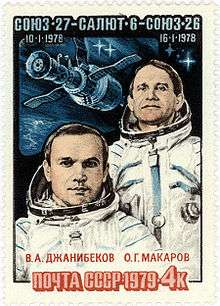Vladimir Dzhanibekov
| Vladimir Dzhanibekov Владимир Джанибеков | |
|---|---|
 Vladimir Dzhanibekov (left) on a 1979 Soviet stamp | |
| Cosmonaut | |
| Nationality | Soviet |
| Born |
13 May 1942 Iskandar, Tashkent, Uzbekistan |
Other occupation | Pilot |
| Rank | Major General, Soviet Air Force |
Time in space | 145d 15h 56m |
| Selection | Air Force Group 5 |
| Missions | Soyuz 27, Soyuz 39, Soyuz T-6, Soyuz T-12, Soyuz T-13 |
| Awards |
|
Vladimir Aleksandrovich Dzhanibekov (Russian: Владимир Александрович Джанибеков, born 13 May 1942) is a former cosmonaut who made five flights.
Biography
Dzhanibekov was born Vladimir Aleksandrovich Krysin (Russian: Владимир Александрович Крысин) in the remote area of Iskandar in what was then Bostanliq District, South Kazakhstan Region, Kazakh SSR (since 1956 – Tashkent Region, Uzbekistan)[1] on 13 May 1942. His family moved to Tashkent soon after his birth.
In 1964 he married Liliya Munirovna Dzhanibekova, who was a descendant of Janibeg, medieval ruler of the Golden Horde. As her father had no sons, Dzhanibekov took his wife's family name in order to honour her ancestry and continue her line of descent, an unusual step for a husband in the Soviet Union.[2]
In 1960 he entered Leningrad University to study physics, where he became involved in flying, something in which he had always been interested. In 1961 he decided to enroll in the V. M. Komarov Higher Military Flying School at Yeisk and simultaneously studied at the Taganrog State University of Radioengineering. Four years later he graduated and became a flying instructor in the Soviet Air force serving at military training unit number 99735 in Taganrog in 1968–1970. In 1970 during the visit of Gherman Titov to the Taganrog-based training unit, he was selected into the team of cosmonauts.[3] This was the same year that he joined the Communist Party.
Dzhanibekov made five flights: Soyuz 27, Soyuz 39, Soyuz T-6, Soyuz T-12 and Soyuz T-13. In all he had spent 145 days, 15 hours and 56 minutes in space over these five missions. He had also performed two EVAs with a total time of 8 hours and 35 minutes. In 1985 he demonstrated the tennis racket theorem, subsequently also called the Dzhanibekov effect, by showing that in free-fall rotation about an object's second principal axis is unstable.
After leaving the cosmonaut program in 1986, he became involved in politics. He was the Deputy to the Supreme Soviet of Uzbek SSR from 1985 until 1990. He is also interested in photography and painting and his works, predominantly about space, are owned by museums and private collectors.
He also became interested in ballooning, and flying around the world. He made only one flight though, which lasted only 30 minutes. He, Larry Newman and Don Moses lifted off in Earthwinds on 13 January 1993 but could not penetrate a strong inversion layer and tore the ballast balloon on a mountain peak.
The minor planet 3170 Dzhanibekov, discovered by Soviet astronomer Nikolai Stepanovich Chernykh in 1979, is named after him.[4]
Honours and awards
- Twice Hero of the Soviet Union (1978 & 1981);
- Pilot-Cosmonaut of the USSR;
- Order of Friendship (Russian Federation);
- Five Orders of Lenin;
- Order of the Red Star;
- Order for Service to the Homeland in the Armed Forces of the USSR 3rd class;
- Medal "For Merit in Space Exploration" (Russian Federation);
- Jubilee Medal "Twenty Years of Victory in the Great Patriotic War 1941-1945";
- Jubilee Medal "50 Years of the Armed Forces of the USSR";
- Jubilee Medal "60 Years of the Armed Forces of the USSR";
- Jubilee Medal "50 Years of the Soviet Militia";
- Medals "For Impeccable Service" 1st, 2nd and 3rd classes.
- Kosmonavtlar metro station in Tashkent commemorates Uzbekistan's contribution to the Soviet space programme including that of Dzhanibekov.
Foreign awards:
- Hero of the Mongolian People's Republic;
- Commander of the Legion of Honour (France);
- Order of the Banner of the Hungarian People's Republic;
- Order of Sukhbaatar (Mongolia).
He is also an honorary citizen of Gagarin, Kaluga (Russia), Arkalyk (Kazakhstan), and Houston (U.S.).
See also
- Tennis racket theorem, or Dzhanibekov effect, a theorem in dynamics involving the stability of a rotating body with different moments of inertia along each axis.
References
- ↑ "Владимир Александрович Джанибеков". ASTROnote. 2 June 2013. Retrieved 21 April 2014.
- ↑ "Владимир Александрович Джанибеков". ASTROnote. 2 June 2013. Retrieved 21 April 2014.
- ↑ Vladimir Dzhanibekov – Сайт школы №50 г.Ташкента. school50.uz
- ↑ Lutz Schmadel (5 August 2003). Dictionary of Minor Planet Names. Springer. pp. 262–. ISBN 978-3-540-00238-3. Retrieved 3 August 2012.
External links
| Wikimedia Commons has media related to Vladimir Dzhanibekov. |
- http://english.ohmynews.com/articleview/article_view.asp?article_class=4&no=363760&rel_no=1
- http://www.spacefacts.de/bios/cosmonauts/english/dzhanibekov_vladimir.htm
- http://www.zarya.info/Diaries/StationsDOS/Salyut6Ex5.php
- http://www.zarya.info/Diaries/StationsDOS/Salyut6Ex1.php
- http://www.astronautix.com/astros/dzhbekov.htm
- http://www.balloonlife.com/publications/balloon_life/9711/rtwretro9711.htm
- http://groups.google.co.nz/groups?selm=9505221540.AA07052%40urania.harvard.edu
- http://books.nap.edu/books/0309085489/html/index.html
- The official website of the city administration Baikonur - Honorary citizens of Baikonur